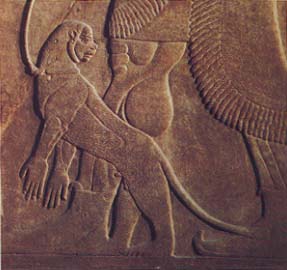Image Details

British Museum
“I seized the entire extent of the Lebanon mountain and reached the Great Sea.” Thus relates an inscribed relief, a detail of which is shown, from the palace of Assurnasirpal II in Kalhu. The Assyrian king “ascended the mountains,” cut down “logs of cedars” and received tribute from conquered kingdoms. Among the gifts from the Phoenician cities of Sidon, Tyre and Byblos were walrus tusks and “large and small monkeys.”
Assyrian inscriptions were a form of political propaganda, but author Tammi Schneider argues that they did not always serve the same political purpose. Unlike the inscriptions of his son, Shalmaneser III, Assurnasirpal’s annals revel in the details of his voyages and in feats glorifying him as a godlike warrior-hero, Schneider observes. Shalmaneser, the head of a more systematic, empire-building power, restricts the list of his accomplishments to those concerning the growth of the Assyrian Empire.
